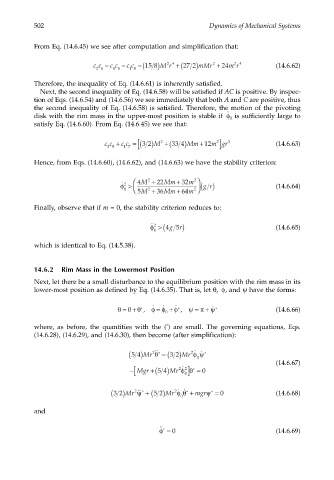Page 521 - Dynamics of Mechanical Systems
P. 521
0593_C14_fm Page 502 Tuesday, May 7, 2002 6:56 AM
502 Dynamics of Mechanical Systems
From Eq. (14.6.45) we see after computation and simplification that:
c c − c c − c c −( 15 8) M r +( 27 2) mMr + 24 m r (14.6.62)
2
24
2 4
26 4 5 1 8
Therefore, the inequality of Eq. (14.6.61) is inherently satisfied.
Next, the second inequality of Eq. (14.6.58) will be satisfied if AC is positive. By inspec-
tion of Eqs. (14.6.54) and (14.6.56) we see immediately that both A and C are positive, thus
the second inequality of Eq. (14.6.58) is satisfied. Therefore, the motion of the pivoting
disk with the rim mass in the upper-most position is stable if φ ˙ 0 is sufficiently large to
satisfy Eq. (14.6.60). From Eq. (14.6.45) we see that:
]
cc + c c = ( [ 3 2) M +( 33 4) Mm 12 m gr 3 (14.6.63)
+
2
2
35 1 7
Hence, from Eqs. (14.6.60), (14.6.62), and (14.6.63) we have the stability criterion:
4M 2 + 22Mm + 32m 2
φ > (gr ) (14.6.64)
˙ 2
0 5M 2 + 36Mm + 64m 2
Finally, observe that if m = 0, the stability criterion reduces to:
φ > ( 5 )
˙ 2
0 4gr (14.6.65)
which is identical to Eq. (14.5.38).
14.6.2 Rim Mass in the Lowermost Position
Next, let there be a small disturbance to the equilibrium position with the rim mass in its
˙
φ
lower-most position as defined by Eq. (14.6.35). That is, let θ, , and ψ have the forms:
* ˙
˙
+
˙
θ =+ θ , φ = φ + φ , ψ = π ψ ˙ * (14.6.66)
0
*
0
*
where, as before, the quantities with the ( ) are small. The governing equations, Eqs.
(14.6.28), (14.6.29), and (14.6.30), then become (after simplification):
( 54)Mr θ − ( 3 2)Mr φ ψ
2 ˙ ˙ *
2˙˙*
0
[ +( 2 2 ˙ 0] * (14.6.67)
− Mgr 54)Mr φθ = 0
( 32)Mr ˙˙ * + ( 52)Mr φ θ + mgrψ * = 0 (14.6.68)
ψ
2
2 ˙ ˙ *
0
and
φ= 0 (14.6.69)
˙˙*

